The Geminids Meteor Shower '04
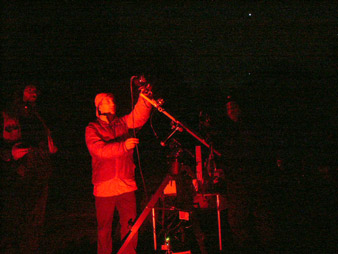 Monday
night Dec 13 the gang agreed to meet at C.T. English School up on Summit to
photograph and watch the Geminids, predicted to put on an unusually strong show
this year under a dark moonless sky. I arrived and Karl joined soon after to
find very wet and foggy conditions; fog was forming right over our heads from
north winds blowing up the ridge. My old friend and noted Bay area astrophotographer
and marine biologist at CSU Hayward - Chris Kitting - joined us soon afterward.
Karl convinced us it was clearer back at his place, and a little meteorological
reasoning led us to move our operation to Highland Way a mile east of Karl's
place. We called Shahram on the cell phone to meet us at the new location, and
arrived there by 10:45pm. Karl was right - it was clear, no wind, and promised
great photos as the fog below blocked the lights of Santa Cruz.
Monday
night Dec 13 the gang agreed to meet at C.T. English School up on Summit to
photograph and watch the Geminids, predicted to put on an unusually strong show
this year under a dark moonless sky. I arrived and Karl joined soon after to
find very wet and foggy conditions; fog was forming right over our heads from
north winds blowing up the ridge. My old friend and noted Bay area astrophotographer
and marine biologist at CSU Hayward - Chris Kitting - joined us soon afterward.
Karl convinced us it was clearer back at his place, and a little meteorological
reasoning led us to move our operation to Highland Way a mile east of Karl's
place. We called Shahram on the cell phone to meet us at the new location, and
arrived there by 10:45pm. Karl was right - it was clear, no wind, and promised
great photos as the fog below blocked the lights of Santa Cruz.
The meteor shower was quite strong, with over 90/hr and many quite bright.
We saw a few brighter than Venus. We're hopeful that several showed up on film.
The brightest meteors were a strong green color from oxygen III emission. Other
reports gave the rates at 160/hour.
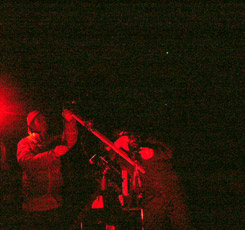 A
highlight was Comet Machholz, a big green ball with two stubby faint tails in
western Lepus below Orion.
A
highlight was Comet Machholz, a big green ball with two stubby faint tails in
western Lepus below Orion.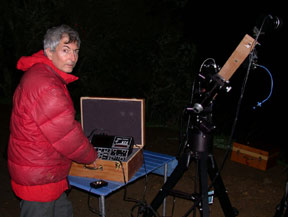 Chris sets up his Takahashi mount and prepares his Nikon for some 300mm shots
of the comet. I'm at left, adjusting the STV videocamera. Jupiter is in the
background to the upper right. Chris' shot of me at right was taken with his
Nikon Coolpix 995 and flash.
Chris sets up his Takahashi mount and prepares his Nikon for some 300mm shots
of the comet. I'm at left, adjusting the STV videocamera. Jupiter is in the
background to the upper right. Chris' shot of me at right was taken with his
Nikon Coolpix 995 and flash.
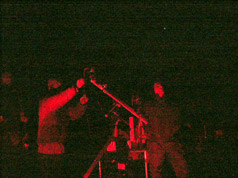 And
here I'm STILL adjusting the STV. Karl watches the STV monitor looking for signs
of the comet while I move the thing this way and that on the ball head mount
attached to the oak mount board clamped to the GM-8. The 100mm Nikon lens gives
this video camera a field of view that's only a couple degrees wide, and it's
very difficult to blindly aim at an object and have it show up on the monitor.
I tried for half an hour before finally getting Comet Machholz to appear on
the frame. Chris is at left, and Shahram has now arrived and is at right.
And
here I'm STILL adjusting the STV. Karl watches the STV monitor looking for signs
of the comet while I move the thing this way and that on the ball head mount
attached to the oak mount board clamped to the GM-8. The 100mm Nikon lens gives
this video camera a field of view that's only a couple degrees wide, and it's
very difficult to blindly aim at an object and have it show up on the monitor.
I tried for half an hour before finally getting Comet Machholz to appear on
the frame. Chris is at left, and Shahram has now arrived and is at right.
Shahram and Chris eventually moved their camera gear to the GM-8, as the polar
alignment is so good that no guiding need be done. We had some close calls as
the whole set-up flopped over twice due to weight imbalance. I'd left the counter
weight rod at the observatory.
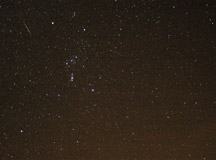 Chris
captured a bright Geminid in Monoceros on this picture using his digital Nikon
D100 set at ISO 400 with Nikor 20mm lens wide open at f/2.8 for about 5 minutes.
Comet Machholz is the small green 'star' to the right of the head of Lepus,
lower right of Orion. As always, click on any blue-bordered pictures for the
full size .jpg version.
Chris
captured a bright Geminid in Monoceros on this picture using his digital Nikon
D100 set at ISO 400 with Nikor 20mm lens wide open at f/2.8 for about 5 minutes.
Comet Machholz is the small green 'star' to the right of the head of Lepus,
lower right of Orion. As always, click on any blue-bordered pictures for the
full size .jpg version. A much brighter Geminid streaked through Lepus, lit by the lights of Santa Cruz
below, a brilliant green to the eye and as bright as Venus. Chris got a nice
photo here, and if you look closely you can see the Orion, Flame, and Horsehead
nebulae. Chris used a Hasselblad with 80mm Zeiss f/2.8 lens wide open for 15
minutes, on Fuji 400F slide film, pushed to ISO 800, and scanned into digital
format.
A much brighter Geminid streaked through Lepus, lit by the lights of Santa Cruz
below, a brilliant green to the eye and as bright as Venus. Chris got a nice
photo here, and if you look closely you can see the Orion, Flame, and Horsehead
nebulae. Chris used a Hasselblad with 80mm Zeiss f/2.8 lens wide open for 15
minutes, on Fuji 400F slide film, pushed to ISO 800, and scanned into digital
format.
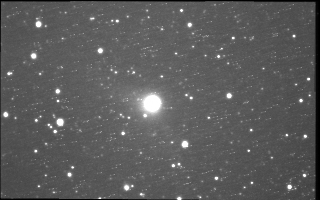 I
took a series of pictures of Comet Machholz using the STV with 100mm Nikon lens
wide open. These were practice shots, trying to learn how to set the options
using the unique user interface of the STV console. At left is a 7 minute exposure;
an align/stack of 7 x 1-minute each. No dark subtraction or flat fielding or
resampling. The comet was low and suffered some from the lights of Santa Cruz.
You'll see the little dotted line segments; these are hot pixels offset from
each other as each frame was aligned and stacked.
I
took a series of pictures of Comet Machholz using the STV with 100mm Nikon lens
wide open. These were practice shots, trying to learn how to set the options
using the unique user interface of the STV console. At left is a 7 minute exposure;
an align/stack of 7 x 1-minute each. No dark subtraction or flat fielding or
resampling. The comet was low and suffered some from the lights of Santa Cruz.
You'll see the little dotted line segments; these are hot pixels offset from
each other as each frame was aligned and stacked. 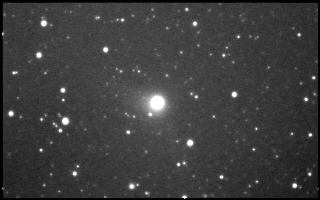 This
comet's two tails are very offset, as it's near opposite the sun in the sky.
The dust tail is at about 10 o'clock, and the ion tail about 4-5 o'clock. At
right is a shorter 1.5 minute exposure, but this time I turned off the auto
dark subtraction. It's an align/stack of 3 x 30sec images with bicubic resampling.
This
comet's two tails are very offset, as it's near opposite the sun in the sky.
The dust tail is at about 10 o'clock, and the ion tail about 4-5 o'clock. At
right is a shorter 1.5 minute exposure, but this time I turned off the auto
dark subtraction. It's an align/stack of 3 x 30sec images with bicubic resampling.
Karl headed home around 2:30am, while Chris and Shahram and I kept at it till
about 4:30am.
 Monday
night Dec 13 the gang agreed to meet at C.T. English School up on Summit to
photograph and watch the Geminids, predicted to put on an unusually strong show
this year under a dark moonless sky. I arrived and Karl joined soon after to
find very wet and foggy conditions; fog was forming right over our heads from
north winds blowing up the ridge. My old friend and noted Bay area astrophotographer
and marine biologist at CSU Hayward - Chris Kitting - joined us soon afterward.
Karl convinced us it was clearer back at his place, and a little meteorological
reasoning led us to move our operation to Highland Way a mile east of Karl's
place. We called Shahram on the cell phone to meet us at the new location, and
arrived there by 10:45pm. Karl was right - it was clear, no wind, and promised
great photos as the fog below blocked the lights of Santa Cruz.
Monday
night Dec 13 the gang agreed to meet at C.T. English School up on Summit to
photograph and watch the Geminids, predicted to put on an unusually strong show
this year under a dark moonless sky. I arrived and Karl joined soon after to
find very wet and foggy conditions; fog was forming right over our heads from
north winds blowing up the ridge. My old friend and noted Bay area astrophotographer
and marine biologist at CSU Hayward - Chris Kitting - joined us soon afterward.
Karl convinced us it was clearer back at his place, and a little meteorological
reasoning led us to move our operation to Highland Way a mile east of Karl's
place. We called Shahram on the cell phone to meet us at the new location, and
arrived there by 10:45pm. Karl was right - it was clear, no wind, and promised
great photos as the fog below blocked the lights of Santa Cruz. A
highlight was Comet Machholz, a big green ball with two stubby faint tails in
western Lepus below Orion.
A
highlight was Comet Machholz, a big green ball with two stubby faint tails in
western Lepus below Orion. Chris sets up his Takahashi mount and prepares his Nikon for some 300mm shots
of the comet. I'm at left, adjusting the STV videocamera. Jupiter is in the
background to the upper right. Chris' shot of me at right was taken with his
Nikon Coolpix 995 and flash.
Chris sets up his Takahashi mount and prepares his Nikon for some 300mm shots
of the comet. I'm at left, adjusting the STV videocamera. Jupiter is in the
background to the upper right. Chris' shot of me at right was taken with his
Nikon Coolpix 995 and flash. And
here I'm STILL adjusting the STV. Karl watches the STV monitor looking for signs
of the comet while I move the thing this way and that on the ball head mount
attached to the oak mount board clamped to the GM-8. The 100mm Nikon lens gives
this video camera a field of view that's only a couple degrees wide, and it's
very difficult to blindly aim at an object and have it show up on the monitor.
I tried for half an hour before finally getting Comet Machholz to appear on
the frame. Chris is at left, and Shahram has now arrived and is at right.
And
here I'm STILL adjusting the STV. Karl watches the STV monitor looking for signs
of the comet while I move the thing this way and that on the ball head mount
attached to the oak mount board clamped to the GM-8. The 100mm Nikon lens gives
this video camera a field of view that's only a couple degrees wide, and it's
very difficult to blindly aim at an object and have it show up on the monitor.
I tried for half an hour before finally getting Comet Machholz to appear on
the frame. Chris is at left, and Shahram has now arrived and is at right.

 I
took a series of pictures of Comet Machholz using the STV with 100mm Nikon lens
wide open. These were practice shots, trying to learn how to set the options
using the unique user interface of the STV console. At left is a 7 minute exposure;
an align/stack of 7 x 1-minute each. No dark subtraction or flat fielding or
resampling. The comet was low and suffered some from the lights of Santa Cruz.
You'll see the little dotted line segments; these are hot pixels offset from
each other as each frame was aligned and stacked.
I
took a series of pictures of Comet Machholz using the STV with 100mm Nikon lens
wide open. These were practice shots, trying to learn how to set the options
using the unique user interface of the STV console. At left is a 7 minute exposure;
an align/stack of 7 x 1-minute each. No dark subtraction or flat fielding or
resampling. The comet was low and suffered some from the lights of Santa Cruz.
You'll see the little dotted line segments; these are hot pixels offset from
each other as each frame was aligned and stacked.  This
comet's two tails are very offset, as it's near opposite the sun in the sky.
The dust tail is at about 10 o'clock, and the ion tail about 4-5 o'clock. At
right is a shorter 1.5 minute exposure, but this time I turned off the auto
dark subtraction. It's an align/stack of 3 x 30sec images with bicubic resampling.
This
comet's two tails are very offset, as it's near opposite the sun in the sky.
The dust tail is at about 10 o'clock, and the ion tail about 4-5 o'clock. At
right is a shorter 1.5 minute exposure, but this time I turned off the auto
dark subtraction. It's an align/stack of 3 x 30sec images with bicubic resampling.